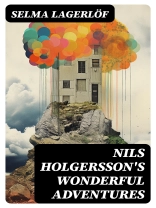In ‘Nils Holgersson’s Wonderful Adventures, ‘ Selma Lagerlöf employs an enchanting narrative style that intertwines elements of fantasy and realism. This beloved children’s novel follows the journey of a young boy, Nils, who, after mistreating animals, is magically shrunk and embarks on a transformative journey across Sweden atop a goose. Lagerlöf’s lyrical prose and vivid imagery not only captivate young readers but also serve as a vehicle for exploring themes of compassion, environmental awareness, and the importance of personal growth within the context of Swedish folklore and nature. The work reflects the author’s deep appreciation for the Swedish landscape and its cultural heritage, blending moral lessons with imaginative storytelling. Selma Lagerlöf, the first woman to win the Nobel Prize in Literature, draws inspiration from her own childhood experiences and Swedish folklore to craft Nils’s adventures. Her passion for the natural world and her commitment to social issues, including her advocacy for education and women’s rights, profoundly influenced her storytelling. Lagerlöf’s literary endeavors often sought to bridge the gap between the fantastical and the moral, making her works timeless and engaging across generations. I highly recommend ‘Nils Holgersson’s Wonderful Adventures’ to readers of all ages, as it not only provides an adventurous escape into a vivid world filled with talking animals and breathtaking landscapes but also imparts essential lessons about empathy and stewardship of the earth. Lagerlöf’s masterpiece deserves a place in the hearts of those who cherish literature that inspires both wonder and moral reflection.
Yazar hakkında
Selma Lagerlöf, born on November 20, 1858, in Mårbacka, Värmland, Sweden, was a prolific Swedish author celebrated for her rich storytelling and contributions to children’s literature. Lagerlöf’s narrative style blends folklore, legend, and realism, marking her as a pivotal figure in the development of Swedish literature. Her most renowned work, ‘Nils Holgersson’s Wonderful Adventures’, originally intended as a geography reader for schools, has captivated audiences with its magical tale of a young boy’s journey across Sweden on the back of a goose. Lagerlöf’s prolific career earned her unprecedented acknowledgment when, in 1909, she became the first female writer to win the Nobel Prize in Literature, honored for the lofty idealism, vivid imagination, and spiritual perception that characterized her writings. Her literary craftsmanship is evident in the empathetic portrayal of characters and the vivid descriptions of the Nordic landscape. Lagerlöf’s contributions have earned her an enduring legacy, influencing not just Scandinavian literature but also the international realm of storytelling. She was also a member of the Swedish Academy, the body that awards the Nobel Prizes, from 1914 until her death on March 16, 1940. Her work remains a testament to her visionary spirit and narrative skill.












